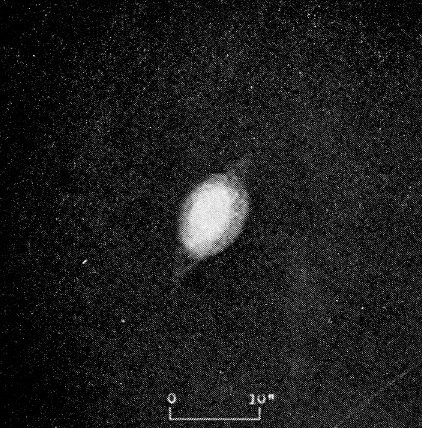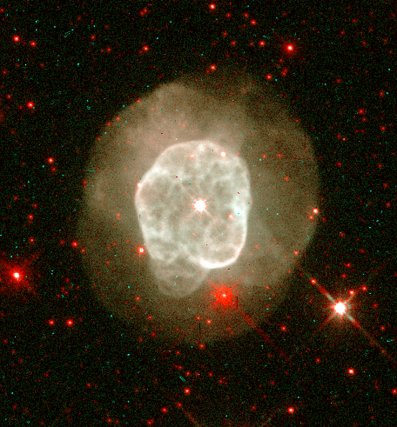NGC 6578
Among the more obscure of brighter planetary nebulae, NGC 6578 is buried
deeply within the star clouds of northern Sagittarius somewhat under a degree north-northeast of
Mu Sagittarii. Far away (from a
combination of inaccurate methods perhaps 6500 light years) and
young, it is angularly small, just 8.5 seconds of arc in diameter,
or about a quarter of a light year across. Curtis (left-hand
image) says little: "Disk nearly round...no ansae or structural
details visible...Rather faint." Hubble on the other hand (at
right) reveals a classic double shell, the inner one filled with
expanding threads of gas and caused by a fast wind from the central
star hammering the outer envelope. While Curtis could not see the
fainter outer halo, he was right, there are no ansae or jets as in
NGC 7009 or NGC
6543. What may seem to be jets in his drawing are (from the
Hubble image) clearly just extensions of the inner shell. Why some
nebulae have ansae and others do not is a mystery. Part of the
object's faintness is due to some three magnitudes of absorption of
light by intervening dust in the thick mid-line of the Milky Way, the nebula a mere 10 degrees from the
center of the Galaxy.
Curtis was close in his assessment of the central star, estimating
it at magnitude 15, which modern methods show to be 15.7.
Combination of nebular and stellar brightness gives a cool (for
such objects) temperature of 63,000 Kelvin (consistent with little
or no ionized helium
radiation) and, from the distance, a
luminosity of about 4000 times that of the Sun. Theory then indicates a core mass (that
of the old nuclear burning remnant of the original star) of 0.57
times that of the Sun, which in turn suggests an initial mass
(before the star lost its outer envelope) of around 1.3 times
that of the Sun, all this discussion very uncertain. Modest mass,
though, goes along with no evidence for chemical enrichment of the
nebula. The star is still in a state of heating with more or less
constant luminosity, and when it hits about 100,000 Kelvin, it will
begin to cool and dim, while the nebula, expanding at about 20
kilometers per second, will dissipate into space, leaving a modest
white dwarf
behind.
Left: Image by H. D. Curtis from Publications of the Lick
Observatory, Volume 13, Part III, 1918. Right: Hubble image by H.
Bond (STScI) and NASA.



